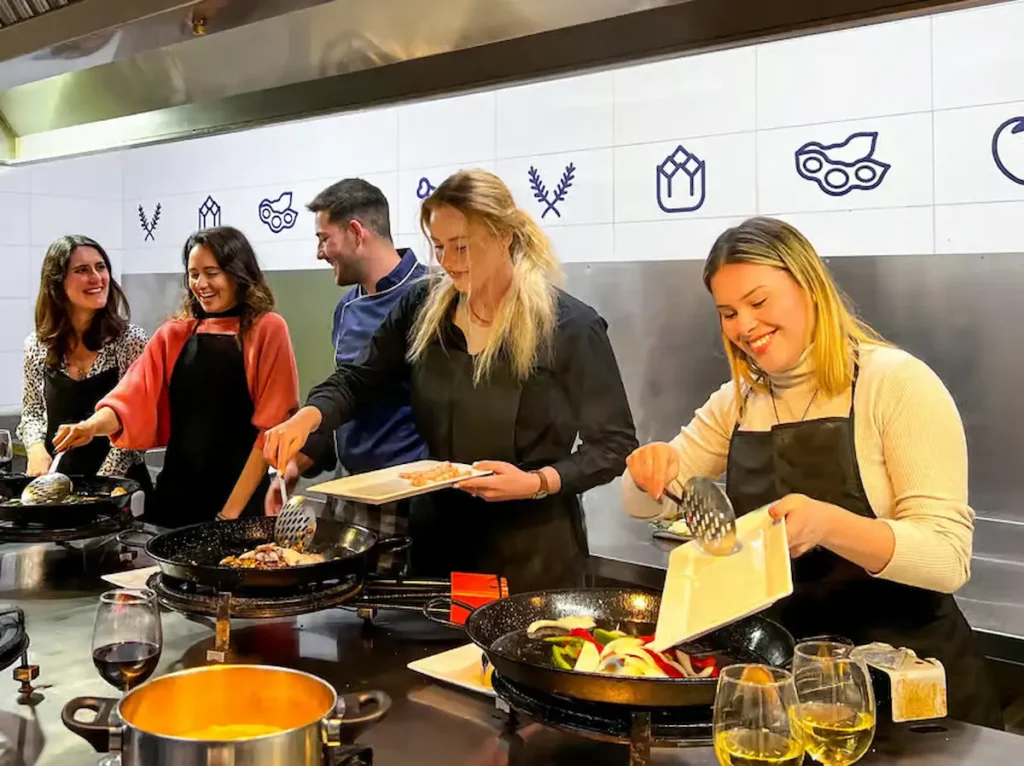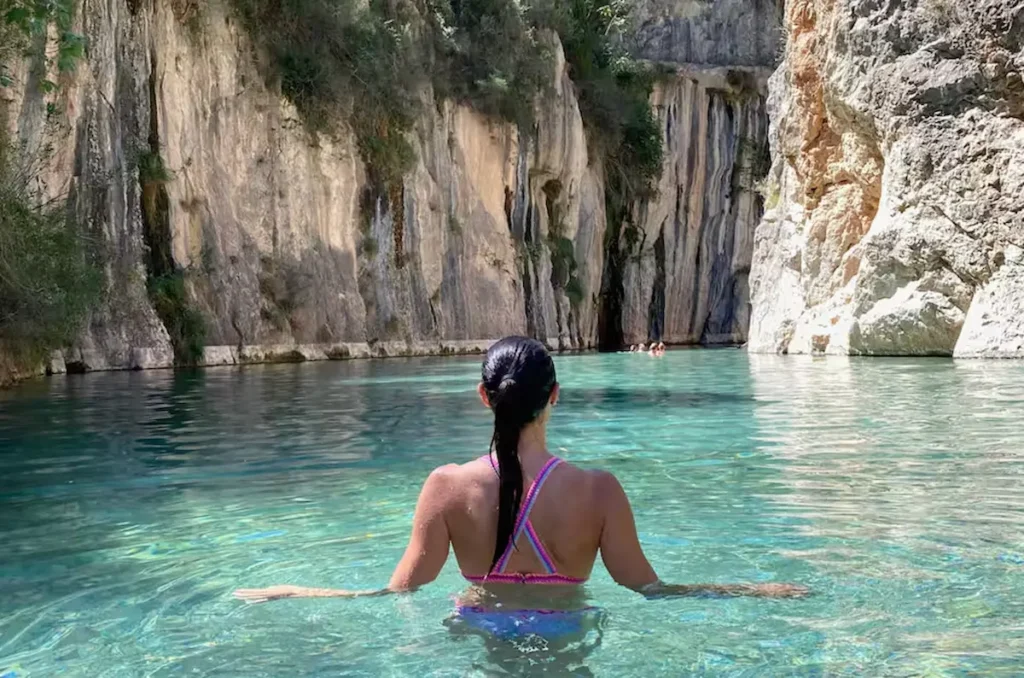Valencia grabbed me by the heart and hasn’t let go since my first visit. Walking through the futuristic City of Arts and Sciences felt like stepping into tomorrow, but turn any corner in the old town and suddenly you’re surrounded by buildings older than your country. I spent my first morning getting lost in the maze of the Mercado Central, watching locals argue over the best jamón while I devoured what might be the best orange juice I’ve ever tasted.
After experiencing all the incredible things to do in Valencia, I get why people fall hard for Spain’s third largest city. From eating the most authentic paella of my life at La Pepica (right on the beach) to biking through the converted riverbed park that winds through the city like a green snake, this place just hits different. Trust me, Barcelona and Madrid have serious competition.
Top Sights to See in Valencia
Visiting Valencia? Spend the day exploring the City of Arts and Sciences, shop at the historic Mercado Central, or relax in the beautiful Jardín del Turia. Discover the architectural wonder of La Lonja de la Seda or unwind at Playa de la Malvarrosa. Whether you’re into history, art, or seaside relaxation, Valencia has plenty to offer.

1. Explore the Futuristic City of Arts and Sciences
If you’re only seeing one spot in Valencia, make it the City of Arts and Sciences. This futuristic complex, designed by Santiago Calatrava, looks like it belongs in a sci-fi movie. You’ll find the Hemisfèric, shaped like a giant blinking eye, along with the Oceanogràfic, which happens to be the largest aquarium in Europe. The whole area is filled with reflecting pools, white arches, and striking curves—it’s a dream for photographers.
I wandered through the Museu de les Ciències Príncipe Felipe and lost track of time. It’s interactive and fun, even if you don’t love science. The complex is so big, you can easily spend a full afternoon exploring it. Bring comfy shoes and a charged phone—you’ll want to take a lot of pictures. This isn’t just Valencia’s most famous attraction, it’s also one of its most mind-blowing experiences.
- This City of Arts and Sciences walking tour explains Calatrava’s architecture and highlights the best photo spots.

2. Learn to Cook Paella at a Class with Market Tour
Cooking paella in Valencia is the best way to dive into local food culture and take home a skill you’ll actually use. The experience starts with a stroll through Mercado Central, picking up fresh ingredients under the guidance of a professional chef, then moves to your cooking station for a hands-on lesson in making traditional Valencian paella.

I enjoyed learning the tricks for achieving the perfect socarrat while sipping a glass of local wine. Each participant gets personal attention, and the small group size makes it easy to ask questions and really absorb the chef’s tips. The class also includes local tapas and dessert, so you’re tasting as you go.
Wear comfortable clothes for cooking, and bring your appetite. If you want to extend the foodie adventure, explore the nearby historic streets after the class for tapas bars and cafés.
- Want to cook it yourself? This paella cooking class in Valencia includes market shopping, wine, and tapas.
3. Shop for Fresh Seafood at Mercado Central
If you’re hungry or curious about local life, Mercado Central is the place to be. This massive indoor market is housed in a stunning Modernist building filled with stained glass and iron beams. Inside, over 1,000 stalls are stacked with fresh seafood, jamón ibérico, cheeses, spices, and produce so vibrant it feels like a color wheel exploded. It’s not touristy—locals actually shop here.
I grabbed a glass of freshly squeezed Valencian orange juice from a vendor and wandered the aisles snacking on olives and local cheese. Vendors were chatting in Spanish, laughing, slicing ham right in front of me. If you want an authentic feel of the city, this market gives it to you in spades. Bonus: it’s super affordable. Whether you’re shopping for picnic supplies or just browsing, Mercado Central is a must-see stop in Valencia.

4. Bike Through Jardín del Turia Park
It’s hard to believe Jardín del Turia used to be a river. After the Turia River flooded Valencia in 1957, the city rerouted it and transformed the dry riverbed into a massive public park. Today, it stretches nearly six miles and cuts right through the city, connecting major sights like Gulliver Park and the City of Arts and Sciences. It’s one of the most relaxing places to walk, run, or bike without leaving central Valencia.
I spent a lazy afternoon here with a rented bike from Doyoubike, coasting under bridges and passing orange trees and fountains. Families picnicked, joggers breezed by, and kids climbed on the giant Gulliver sculpture. You’ll also spot playgrounds, cafés, and shady benches every few minutes. Jardín del Turia isn’t just a park—it’s Valencia’s green lifeline. If you need a break from sightseeing, this is the perfect spot to slow down and reset.

5. Sample Wines at Two Wineries in Utiel-Requena
Spend a day exploring the vineyards of Utiel-Requena, just an hour from Valencia, with this small-group wine tour. You’ll visit two very different wineries, learning about their history, winemaking process, and local grape varieties along the way. Traveling by private transport makes getting between estates effortless, so you can focus on tasting and learning.

I especially enjoyed comparing the wines from each estate and chatting with the passionate hosts about their craft. The small group size meant plenty of personal attention, and the guided tastings paired with local snacks made the experience feel both fun and educational.
Bring a notebook if you like jotting down tasting notes, and consider stopping at a nearby village after the tour to enjoy a casual walk through the vineyards and pick up local treats to take home.
- If you’re into wine, this Utiel-Requena winery tour visits two estates with tastings and transport included.
6. Tour the Gothic Silk Exchange at La Lonja
History lovers, don’t skip La Lonja de la Seda—this Gothic building used to be a major silk exchange. Built in the 15th century, it’s a UNESCO World Heritage Site and one of the best-preserved examples of late Gothic architecture in Europe. The twisting stone columns in the main hall are wild to see up close, like something straight out of a fantasy novel.
I visited on a weekday morning when it was quiet, and the echo in the grand hall gave me goosebumps. The Sala de Contratación still feels like business is about to go down, even centuries later. The orange tree courtyard outside is a peaceful little break before heading back into the city. It’s a short visit, but 100% worth it—especially if you like places that feel frozen in time.

7. Swim and Eat Paella at Playa de la Malvarrosa
When the sun’s out, Playa de la Malvarrosa is where the city heads. Located just a short tram ride from central Valencia, this wide, sandy beach is perfect for swimming, sunbathing, or playing volleyball. The promenade, lined with palm trees and seafood restaurants, gives it that classic Mediterranean vibe without feeling overrun by tourists.
I grabbed lunch at La Pepica, a beachside restaurant famous for serving paella to Hemingway, and honestly, it lived up to the hype. Afterward, I walked it off with a barefoot stroll along the water. Whether you’re up for renting a paddleboard or just want to chill with a book, Malvarrosa gives you plenty of space to do it. It’s not the flashiest beach in Spain, but it’s a local favorite for a reason—easygoing, scenic, and just enough buzz to keep things interesting.

8. Swim in Thermal Springs and Hike to Waterfalls in Montanejos
Escape Valencia on a full-day trip with 9:30am pickup at Nord station. Highlights include the 60-minute Bridal Veil waterfall, swimming in 25°C Blue Lagoon mineral springs, canyon views, village lunch, and use of a private guesthouse with showers and storage, returning by evening.

Mike and his guides lead the way through scenic villages and mountains, with stops at the waterfall and crystal-clear springs. Swimming is optional, but water shoes and flotation gear make it easy to enjoy safely.
The canyon trails and mineral pools are incredible, and small group sizes let you move at a relaxed pace while hearing local stories. Bring a towel and camera, and if you have extra time, stroll through Jérica to see its Moorish tower and cherry orchards along the way.
9. Take a Boat Through Albufera Natural Park
Just 30 minutes from the city, Albufera Natural Park feels like a different world—calm, quiet, and covered in rice fields. It’s also where paella was born, and that’s reason enough to go. The best way to explore is by taking a boat ride through the shallow lagoon, especially around sunset when the sky reflects perfectly on the water.
I booked a boat tour with a local fisherman in El Palmar, and it was the most peaceful part of my trip. We drifted past birds, reeds, and tiny islands, with barely a sound except the oars in the water. Afterward, I had a steaming pan of seafood paella at Restaurante El Rek, which came highly recommended—and deserved it. Albufera isn’t flashy, but if you’re into nature, local food, and slower travel, it’s a must-do near Valencia.
- Chasing sunset views? This Albufera Natural Park boat tour from Valencia includes transport and a guided nature walk.
- Read Next: 12 Must-Try Experiences in Spain

10. Climb the Tower at Valencia Cathedral
Even if you’re not big on churches, Valencia Cathedral is worth a visit—especially for the story behind its most famous relic: the Holy Grail. Yep, this is one of the places that claims to house the real deal, tucked away in a quiet chapel inside. Whether you believe it or not, it adds a fun twist to exploring this Gothic-meets-Baroque cathedral.
I climbed the Miguelete Tower for views over the rooftops and orange-lined plazas, and it was surprisingly worth the 207 steps. The climb is tight, but the 360-degree view of the city skyline makes it a solid workout reward. Inside, the mix of art and architecture spans centuries. Whether you’re into stained glass or historical mysteries, the cathedral has layers to unpack—and it doesn’t feel overly touristy. Add it to your list even if you just want the view from the top.
- Learning the backstory adds depth: This Valencia Cathedral walking tour covers the Holy Grail and historic highlights.

11. Walk the Underwater Tunnel at Oceanogràfic
If you’re into aquariums, Oceanogràfic in Valencia is next-level. It’s Europe’s largest, with massive tanks and themed areas that span everything from the Arctic to the Mediterranean. The underwater tunnel is especially cool—sharks, rays, and giant fish glide over your head as you walk through it.
I spent a full afternoon here and still didn’t catch everything. The dolphin show was surprisingly well done and not overly cheesy, and I loved the penguin exhibit inside the icy Antarctic dome. There’s even an underwater restaurant if you want to dine surrounded by glowing blue tanks. Whether you’re visiting with kids or just want to feel like one again, this place is easy to get lost in. Oceanogràfic is part of the City of Arts and Sciences, so you can easily pair it with other attractions nearby for a full day out.
- Skip the ticket line: Get your Oceanogràfic entry ticket in advance for same-day access.

12. Try Horchata and Fartons at Horchatería Santa Catalina
If you want to taste a true Valencian classic, Horchatería Santa Catalina is the place. Located in the historic center near Plaza de la Reina, this café has been serving horchata de chufa (a sweet, nutty drink made from tiger nuts) for over two centuries. It’s one of those “you’ve got to try it once” kind of local traditions.
I popped in on a hot afternoon and ordered horchata with a side of fartons—long, sugar-dusted pastries made for dunking. The tiled interior alone is worth a look, with colorful ceramics covering the walls. It’s charming, busy, and full of locals, which is always a good sign. Even if you’re not a fan of super-sweet drinks, it’s worth trying once for the experience. If you’re visiting Valencia and wondering where to cool off like a local, Horchatería Santa Catalina is the spot.

13. Wander the Street Art in Barrio del Carmen
Barrio del Carmen is Valencia’s artsy, slightly grungy neighborhood that’s perfect for wandering with no real agenda. It’s filled with narrow cobblestone alleys, bold street art, hidden cocktail bars, and tiny vintage shops. It’s where old architecture and creative energy mix in a way that feels totally unforced.
One afternoon, I stumbled into Café de Las Horas, a chandelier-lit lounge that serves Agua de Valencia by the pitcher—it was a great accidental find. Around every corner, there’s something new to look at: a medieval tower, a modern mural, a weird little sculpture on a random building. It’s a place that rewards curiosity. If you want to see Valencia’s quirky, creative side, skip the main squares for a while and spend an hour or two just getting lost in El Carmen.

14. Relax in the Botanical Garden
Valencia’s Botanical Garden, known as Jardí Botànic de la Universitat de València, is one of the most relaxing spots in the city. Tucked just outside the old city walls, it’s a peaceful escape filled with palms, succulents, medicinal herbs, and greenhouses. It’s the kind of place where time slows down.
I wandered in one late morning after a noisy walk through the old town and immediately felt the difference—birds chirping, shaded benches, and barely any people around. The cactus section is especially cool, with spiky, alien-looking plants stretching out in all directions. If you’re looking for a break from sightseeing or just need a shady place to sit, Valencia’s Botanical Garden delivers. It’s also a great place for photos if you’re into plants or architecture. No flashy fountains or big crowds—just calm.

15. See Spanish Masters at Museo de Bellas Artes
If you’re into classic art, the Museo de Bellas Artes de Valencia is absolutely worth your time. It’s one of Spain’s top fine arts museums, and it doesn’t feel stuffy or overwhelming like some bigger ones. The building itself is beautiful—light-filled, with arched windows and an elegant courtyard.
I stopped by on a weekday morning and had entire rooms to myself. Inside, you’ll find works by Velázquez, Goya, El Greco, and other Spanish masters, along with religious art from centuries past. Even if you’re not an art history buff, the museum is laid out in a way that’s easy to explore. Plus, admission is free, which makes it an even better excuse to check it out. If you’re in the mood for a quiet, cultured break, this is a solid pick that’s often overlooked by tourists.






